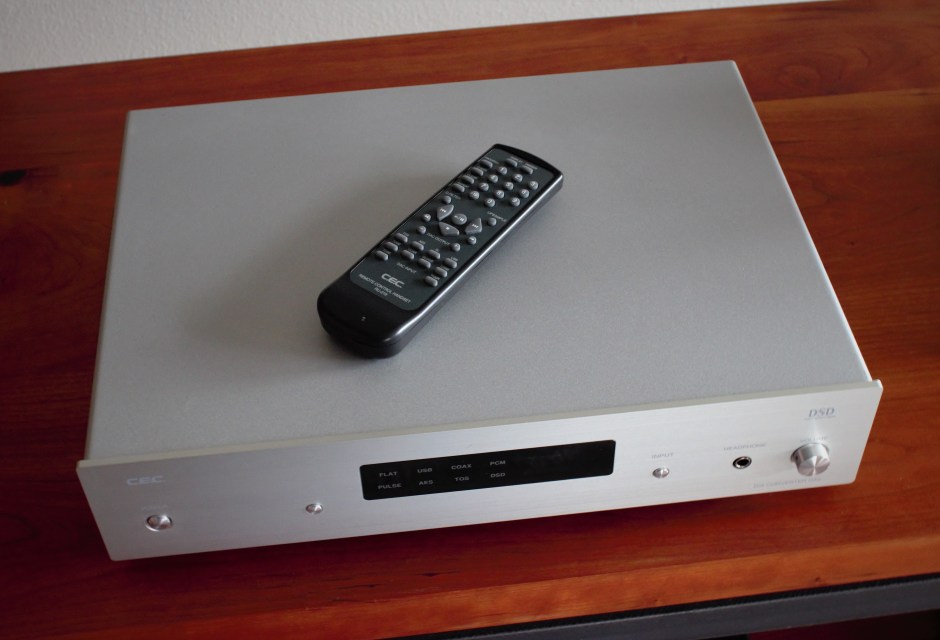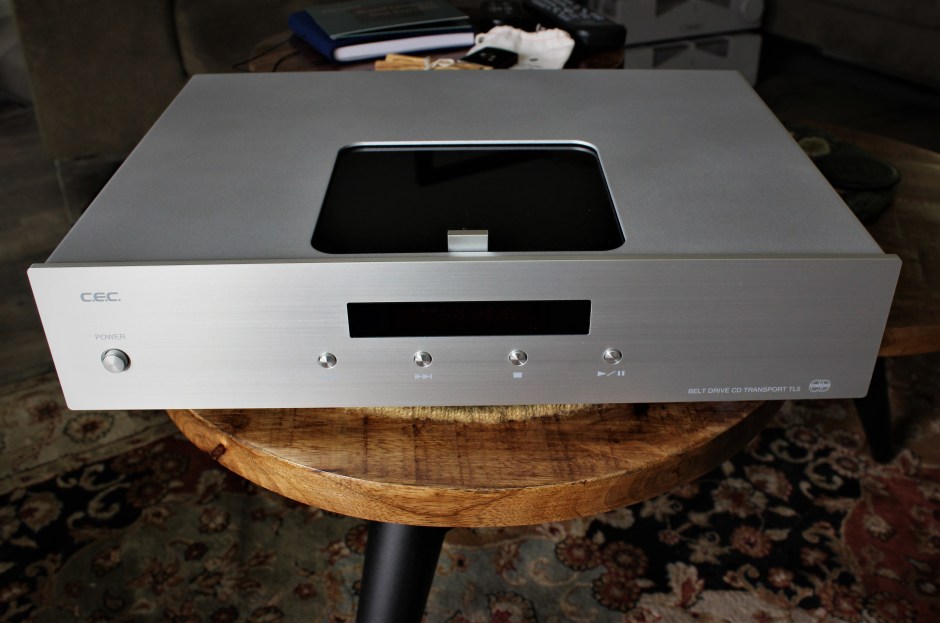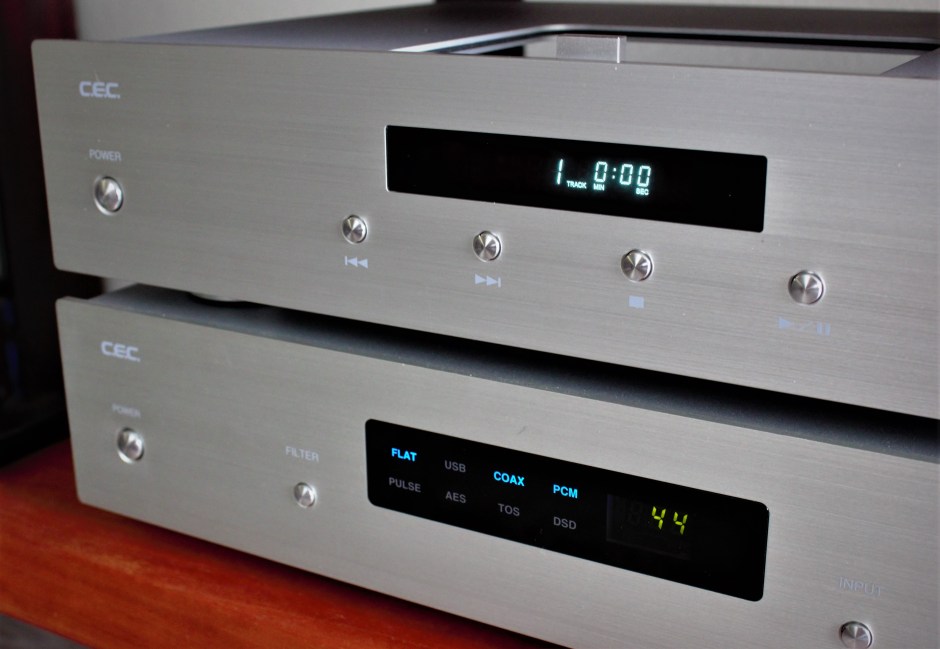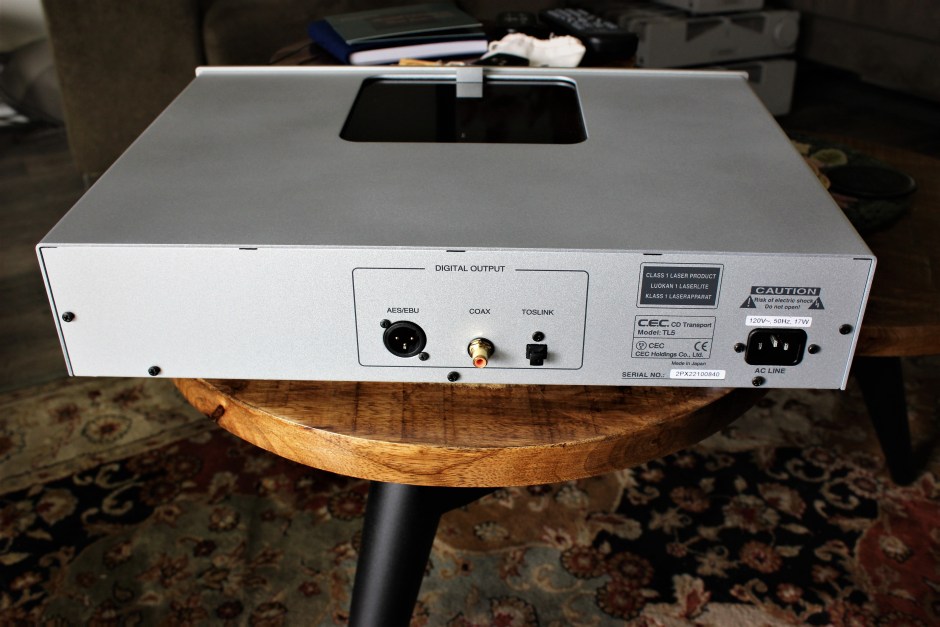The CEC DA5 DAC and matching TL-5 transport represent my new favorite thing in the world of high-end audio—a product that makes you rethink how you want to proceed in this hobby.
I first encountered that feeling a few months ago when I reviewed the Rotel CD14MKII CD player with the Audio by Van Alstine DVA preamplifier. As I mentioned in those two reviews, I’ve been deep in thought about what to do with my CD collection. My CD player, a Unison Research CD-E, has been in service for almost a dozen years, which is eons in CD Player Time. What do I do on the day the CDE decides to give up the ghost, like all of my previous CD players have?
Words and Images by Marc Phillips
The first option I seriously considered, ripping all my CDs to a server, became one step closer to reality when I reviewed the Innuos Zen Mini Mk. 3 along with the Merason Frerot DAC and Pow1 external power supply. This is the future of digital, I concluded, and I thought about finally getting rid of all the racks of CDs that currently litter my listening space. The Rotel player, on the other hand, reminded me that I could still be happy with an $899 CD player if I was really that eager to maintain my CD collection.
The CEC DA5 DAC and TL-5 transport, however, has further refined the ideas I have about the future of my large and still expanding CD collection. Why? I think this has a lot to do with the idea of a separate CD transport and DAC, something I haven’t really explored until now. The CEC TL-5, I’ll admit, is the very first time I’ve played with a dedicated digital transport. I’ve always loved one-box players and I’ve thought, until the last few years, that I would probably buy another excellent all-in-one CD player if the CDE ever ran out of mojo. That’s why I had such a great time reviewing players like the $6,000 McIntosh CD600 and the $10,000 Audio Research CD6SE—this was certainly the next step for me “if and when” the circumstances dictated.
(I won’t even mention how the built-in CD player in the AVM Ovation CS 6.3 was so good, I started considering that as a third possible option.)
But the CEC DA5 and TL-5 present a new, cogent option, one that smacks of “you can have it all if you really want.” I can have all the modern features and flexibility of a modern digital player, meet my standards for sound quality, and at a price that is roughly the same as my Unison Research CDE was in 2011. That’s just nuts.
CEC DA-5 DAC
I had the CEC DA-5 DAC on hand for a good month before the TL5 transport arrived. That’s because the US distributor of CEC, Thomas Kleinbeck of Audio Union, had the DA5 in stock, but he had to order a freshly baked TL5 from Japan. I had just sent the AVA DVA preamplifier on to our Graig Neville, so I definitely needed another DAC in the reference system.
I don’t know if I’m going to start calling this the Phillips DAC Test (not Philips), since I’ve talked to so many other streaming newbies who feel the same way, but you probably know my first priority when it comes to digital audio: I want things to work the first time. I want to hook a DAC up to my laptop via USB, fire up Qobuz, and start hearing music. As my experience with DACs and digital streamers and network and servers expands, I encounter fewer problems than ever—which does imply user error at some level. I ain’t shy about admitting that.
But a flawless DAC installation, where I can be listening to Qobuz within a couple of minutes, has only happened twice so far—with the AVA DVA digital preamplifier, and now the CEC DA-5 DAC. Just bam bam bam and now we’re having fun listening to our favorite tunes. Didn’t even need the owner’s manual.
There is a second, trickier part to the Phillips DAC Test, and it has to do with sound quality. I’ll admit it right now—I find most of the DACs I’ve tested yield wildly different sonic results. That sound has ranged from “everything sounds kind of weird” to “well, this sounds at least as good as playing CDs on the Unison” to “okay, now we’re talking hi-rez!” Of course, this is highly dependent upon the source material, not to mention sampling rates and filters and such, but the CEC DA-5 offered consistently excellent results across the board, no matter the technology.
At first I had that McIntosh 275 feeling, that if every piece of music sounds this good, is something missing? Fidelity is truth, right? Crappy recordings should sound crappy, yes? I finally realized that the issue wasn’t the CEC DA5 sounding too pretty, but all the endless reissues and remasters offered on streaming service like Qobuz on in the digital domain. If I want to hear an old favorite, I’m often given several choices—the 2005 reissue, the 2012 reissue, the MoFi version, etc. If I have the choice, I always pick the one that represents the best sound quality. So I’m probably stacking the deck here, but I just seemed to spend less time with sonic clunkers than usual with the CEC.
The CEC DA5 uses an ESS Hyper stream DAC chip ES9018K2M compatible with 32-bit 384kHz PCM and 11.2 MHz DSD 256. You also get to choose between two digital filters, FLAT and PULSE. The former, as you might expect, offers linearity all the way up to 20kHz, while the latter uses a pulse modulated filter to create a slight roll-off at the top. For me, it was like choosing between ultralinear and triode on a power amplifier—the PULSE setting sounded slightly more musical, but FLAT will allow you to hear deeper into the presentation.
CEC has also recently upgraded their power supplies, not an uncommon practice these days. What’s unusual is that three different versions of the power supplies are now used–one for North America, one for Japan and one for the EU. Not every manufacturer does this–I know this from experience, and a couple of fried transistors.
One more thing: the CEC DA5, as you might have noticed, has a built-in headphone amplifier. That’s right, you can just hook up the DA5 to your laptop server, plug in a pair of headphones, and be deliriously happy. That’s exactly what I did.
The CEC DA5 retails for $3,700. The casework isn’t as extravagant as some of the other DACs I’ve tested, but the sound quality will convince you this is still a bargain. This is a product that puts the best stuff inside the box, and that’s not a problem for me.
CEC TL-5 Transport
The CEC TL-5 is the updated version of that remarkable belt-drive transport design that first appeared back in 1991, when the idea that “CDs might not be the sonic equivalents of analog after all” was starting to gain steam among audiophiles. The idea of digital that sounded more like analog was on everyone’s minds at the time—unless, of course, you adopted the CD technology early and never looked back.
The idea for the belt-drive transport on a CD player certainly makes sense—the thinking behind this closely aligns with the best turntable designs, i.e. keeping the distance between the motor and the needle as large as possible. CEC explains this succinctly in their new, updated belt-drive design:
“The Belt-Drive system allows the drive motor to be moved away from the spindle and the associated electronics reducing the effects of electromagnetic motor noise caused by the motor rotation.
“In order to read the signal recorded with Constant Linear Velocity (CLV) on CD, rotation speed should be slowed down as it goes to the outside. Usually the spindle motor controls the variation of speed. All CD players and transports place the spindle motor beneath the turntable for CD and the motor shaft works as the turntable center, this is called direct drive system. Stable and accurate rotation requires a bigger torque of motor itself, which inevitably creates certain vibration and the electromagnetic noise.
“In CEC TL-5 the spindle motor is placed independently from the center shaft and vibration as well as electromagnetic noise effect to the CD are thus minimized. A heavy CD stabilizer provides bigger inertia of turntable and achieves a stable and smooth rotation of discs. Smaller torque motor and longer distance from the motor to the center shaft (turntable) create the ideal fundamentals of music reproduction.”
Digital outputs include AES/EBU, Coaxial and Toslink. (I used the AudioQuest Carbon digital coax cable that became a favorite when I used the Rotel with the AVA DVA preamplifier.) You can also choose one of two disc stabilizers when you buy your TL-5—the smaller stock version, which is little more than a puck, and the TL-2N stabilizer (a $300 option). The TL-2N is much larger and heavier, more like a record clamp on a turntable—the disc is completely covered inside the top-loading well for the CDs.
I tested the differences between the two stabilizers, and I found subtle differences—the TL-2N added some weight to the lower frequencies, and the focus on the entire presentation was a bit sharper. Not a huge difference, I thought at first, but over time I stopped using the smaller stabilizer completely. The more I think about it, the more I realize that my subconscious was exerting its opinion on the matter. Use this one for the best results. In fact, this was the same response I had to switching back and forth between FLAT and PULSE on the CEC DA5—PULSE just sounded more to my liking in a very general sort of way, and I stuck with it over time.
The TL-5 is a perfect cosmetic match with the CEC DA-5 DAC. After I explored the DA5 and its capabilities while streaming, I spent much of my review period enjoying the CEC DA5 and TL-5 as a simple CD player—albeit in two boxes. Again, the CEC TL-5 is surprisingly affordable for the quality of sound, starting out at $3,095. My sample unit came with both the optional TL-2N stabilizer and the fancier aluminum remote control.
One more note about the price–for a limited time you can get the CEC DA-5 DAC and TL-5 transport together as a package for $6,400. That way you can upgrade to the TL-2N stabilizer and still save money.
CEC DA5 and TL-5 Sound
From that first listening session with the CEC DA5, I knew I had wandered into something quite special. When I added the TL-5 to the equation, I knew I had found my digital audio spirit animal.
With just the CEC DA5 in my system, I felt I had a complete understanding of the joy a simple DAC could bring to my system. It felt like a solution for my system, something I genuinely needed, as opposed to something I had to learn how to use, and with mixed results even after the dust cleared. Again, I was concerned that so many digital sources through the DA5 sounded so warm and smooth and detailed to my ears, sources that previously made me shut my laptop server in frustration and pull out an LP. With the DAC5, however, I had marathon streaming sessions. I know I’ve said that before, but this time is different: I would walk into the listening room and immediately fire up Qobuz without thinking. This wasn’t work, it was fun.
And that sense that everything sounded too good to be true? What a stupid idea that is. For the first time in a long time, I felt hooked on music. I felt like I couldn’t get enough.
Once I added the CEC TL-5 transport to the mix, I was able to home in more objectively on what I was hearing. And the first thing I heard was silence. Now I still remember the first time I heard a CD player in 1982, and how I was stunned by Tchaikovsky’s Romeo and Juliet emerging from complete silence. No whump of the needle hitting the record, no pops and clicks. So, the idea that digital should sound quiet seems less than newsworthy.
Over the years, however, I’ve grown accustomed to the idea that a high-end audio system should be incredibly quiet, even when you’re spinning records. My recent foray into various grounding products has confirmed this—the quieter a system is, the more music you’ll hear. We’re talking about something deeper than an absence of noise. We’re talking about the actual sound of silence, the feeling and physical pressure it exerts, the fact that we can call such silences “black” because, well, that’s the best way to describe it.
The CEC TL-5 created that additional dimension to the silence between the notes in the same way a truly magnificent analog rig—such as the Brinkmann Taurus I reviewed—delivers with regularity. My brain tells me this is the belt-drive transport at work, and that’s the reason I keep making references to analog sound. CEC has always claimed that their products are able to recreate that analog “sound,” that richness and additional texture and space to the music, because of that belt-drive.
Listening to the CEC DA5 and TL-5
I had the CEC gear in for a few months, which meant they saw a lot of service with an assortment of system configurations. As usual, I’ll focus on what I consider the “sweet spot” system, which included the Lab12 Integre4 integrated amplifier ($4,450), the Bowers & Wilkins 805 D4 monitors ($8,500/pr) all hooked up with AudioQuest cabling and power conditioning. This system captured my heart because it supplied me with the high-quality sound that I need, and at a price that is not at all crazy. I spent many hours listening to this system.
I’ve rediscovered a CD that a reviewed some time ago, Borjoner from Aimee-Jo Benoit and Trio Velocity, just because it took me this long to recognize its superior sound quality. This is an intimate jazz performance, a piano trio with female voice, that seems to offer just a little bit more in terms of space, detail and the all-important human movement and interactions with musical instruments. The opener, a surprising deconstruction of Nirvana’s “All Apologies,” turns into a bit of an epic due to the long journey it takes from beginning to end. I fell in love with this album on its second go-around in my rotation thanks to the CEC’s ability to dig and reveal so much about the performance. I poked around in the recording space and found so many new things to love, which leads me to believe that the CEC DA5 and TL-5 is a CD player that makes you want to pull out old CDs and listen to them again. Audiophiles like to say that a lot about other types of high-end audio components, including stand-alone DACs, but a CD player? In 2022? It’s all true.
On the streaming side, the province of the CEC DA5, I suppose I could summarize my impressions with three words: Pink Floyd Marathon.
Oh yes, I fired up the Qobuz machine and just started listening to my faves—Meddle, Animals, even my first complete run-though of The Wall in many, many years, and I simply couldn’t stop. Usually Pink Floyd sounds awesome—because it is awesome—but now I could hear everything said in the background of The Wall, DSOTM, even some of Roger Water’s solo works, and for the first time I got it all, the missing details, and what they bring to the entire story.
The CEC duo never flagged, never made me think about switching to vinyl, never made me suffer from streaming fatigue—which usually happens when I run out of things I want to hear. That’s the point—the CEC DA5 DAC and TL-5 transport made me want to keep listening, deep into the night, even though I’m getting old and I’m usually in bed by 10pm these days. I felt rejuvenated with this level of digital playback. Yes, it was a total surprise to me.
CEC DA5 and TL-5 Conclusions
It should be obvious by now that I loved my time with the CEC DA5 DAC and TL-5 transport. But first, let me tell you what’s happening in high-end audio right now. I keep meeting people who say, “You know, I’m still amazed at the sound of some redbook CDs.” I am, too. Every time I review a CD player or a CD transport, I must wade through the usual chortling, the grumblings that imply I’m wasting my time with a market segment that will soon be relegated to oblivion. It’s starting to sound like 1991 again, when people said the same thing about vinyl.
Here’s a tip—people are still into playing CDs. And the CEC TL-5, mated to the CEC DAC5, took my CD collection to a whole new level of listenability. If I had the CEC combo in my home, I would stop worrying about what I’m going to do with all these CDs everywhere.
But it gets better. The CEC DA5 allows you to listen to your CD collection while still uncovering the new treasures to be found with hi-rez digital and streaming in general. You can jump between all sorts of digital sources, with little effort thanks to the remote control, and listen to anything according to your desires. A lot of digital products can certainly offer you that same flexibility, that ease of operation, so that’s not the reason to buy the CEC DA5 and TL-5 combo. The real reason is that CEC got me interested in my CD collection again, imbuing those listening sessions with the same sense of discovery that I felt when streaming services finally met my standards for sound quality. That’s why the CEC DA5 DAC and the TL-5 transport earns my respect, maybe even love, and a Reviewers Choice award.

















I had the same journey done cheaper buying the project rs2 transport and DAC. Suddenly every cd was a rediscovery, a joyful one. Always loved the thought of the Cec but in the UK the prices are sky high
I considered getting the CEC TL-5 back in March to compliment my Technics SU-G700M2 but went with the matching SL-G700 SACD player and couldn’t be happier. Back then, the price at Audio Union was just around $1850. Reading your review revived an interest in just getting it to see how it performs but with todays pricing, that’s too much to ask. Too bad, as it’s still a top contender for a CD based system.